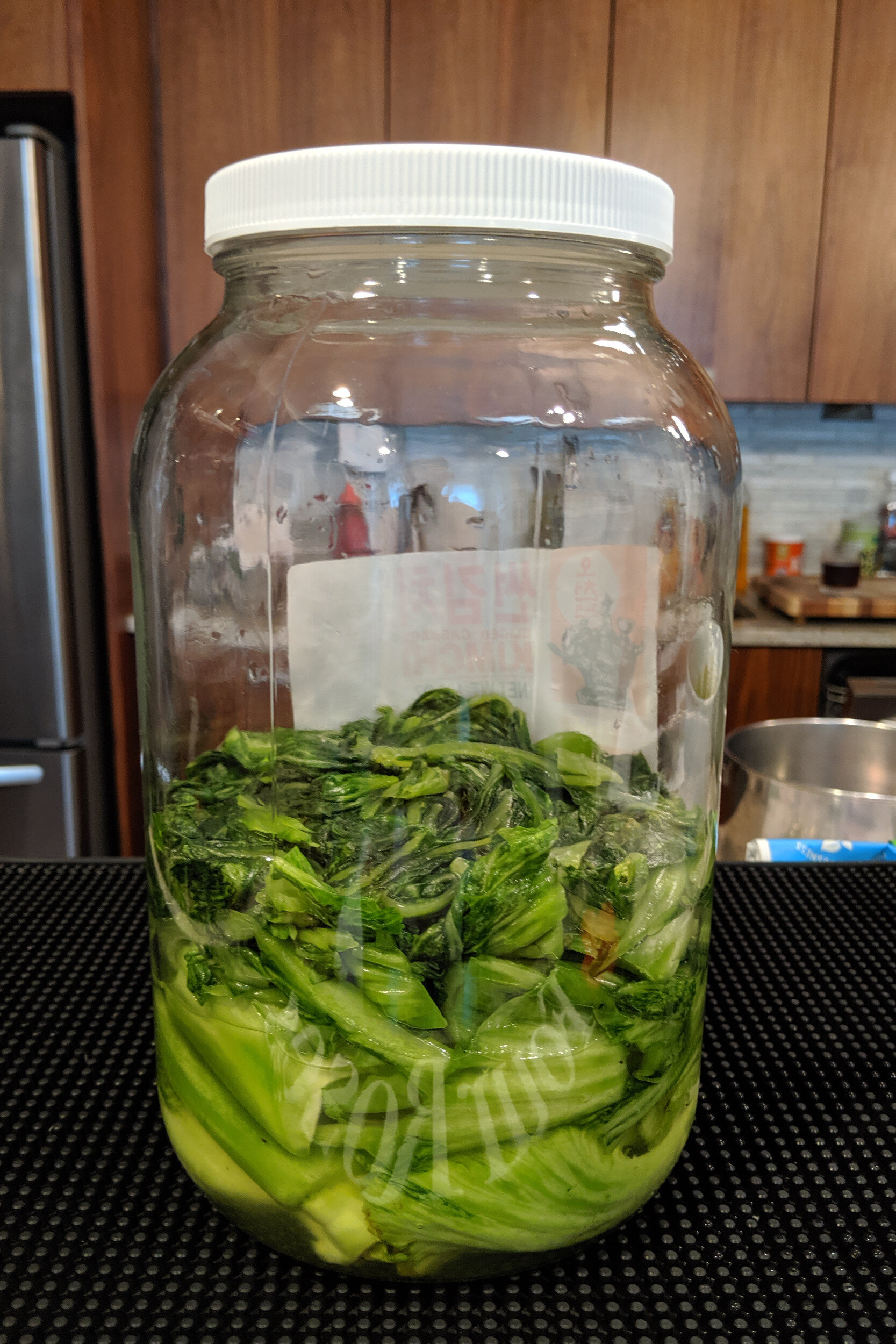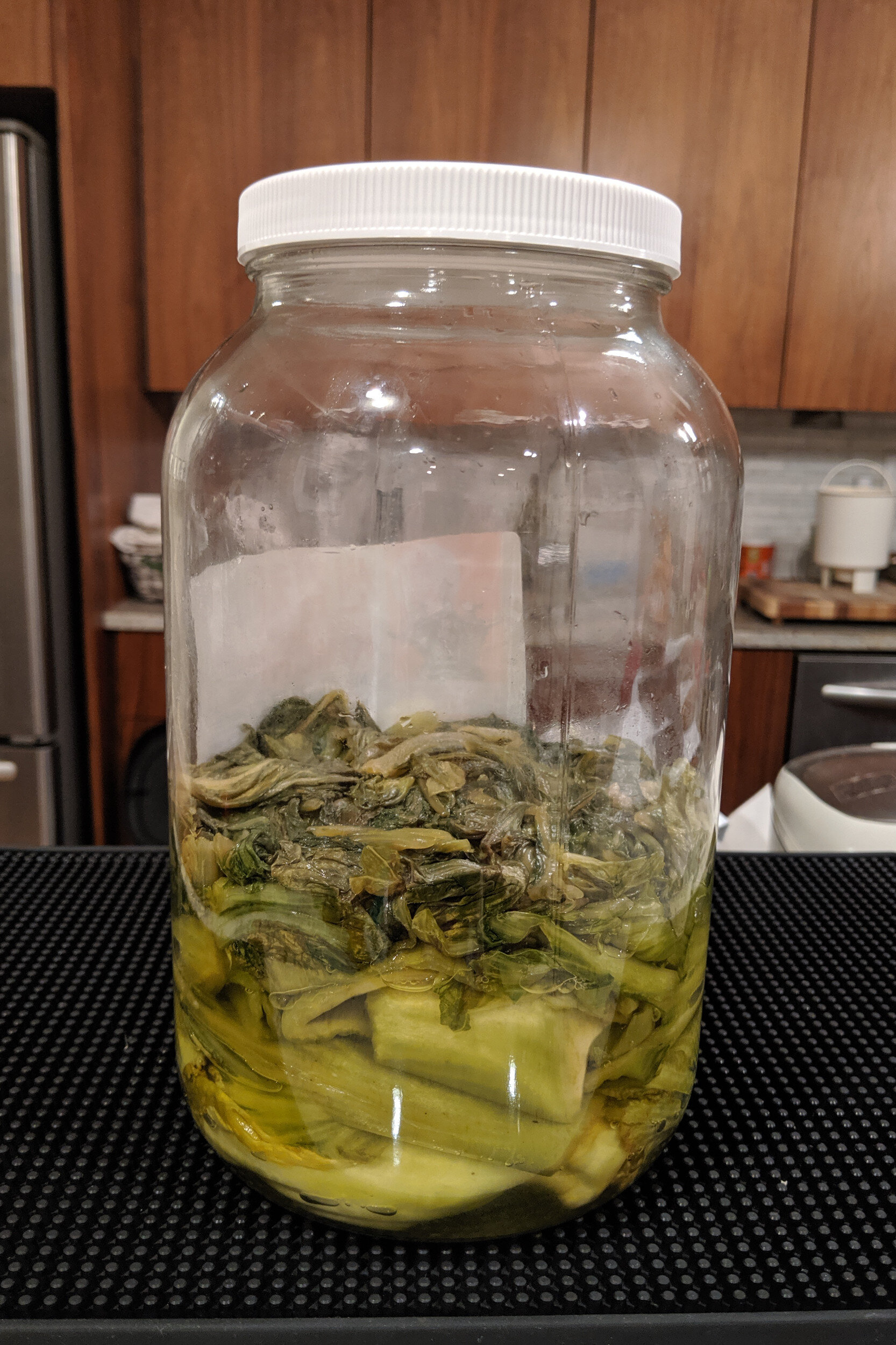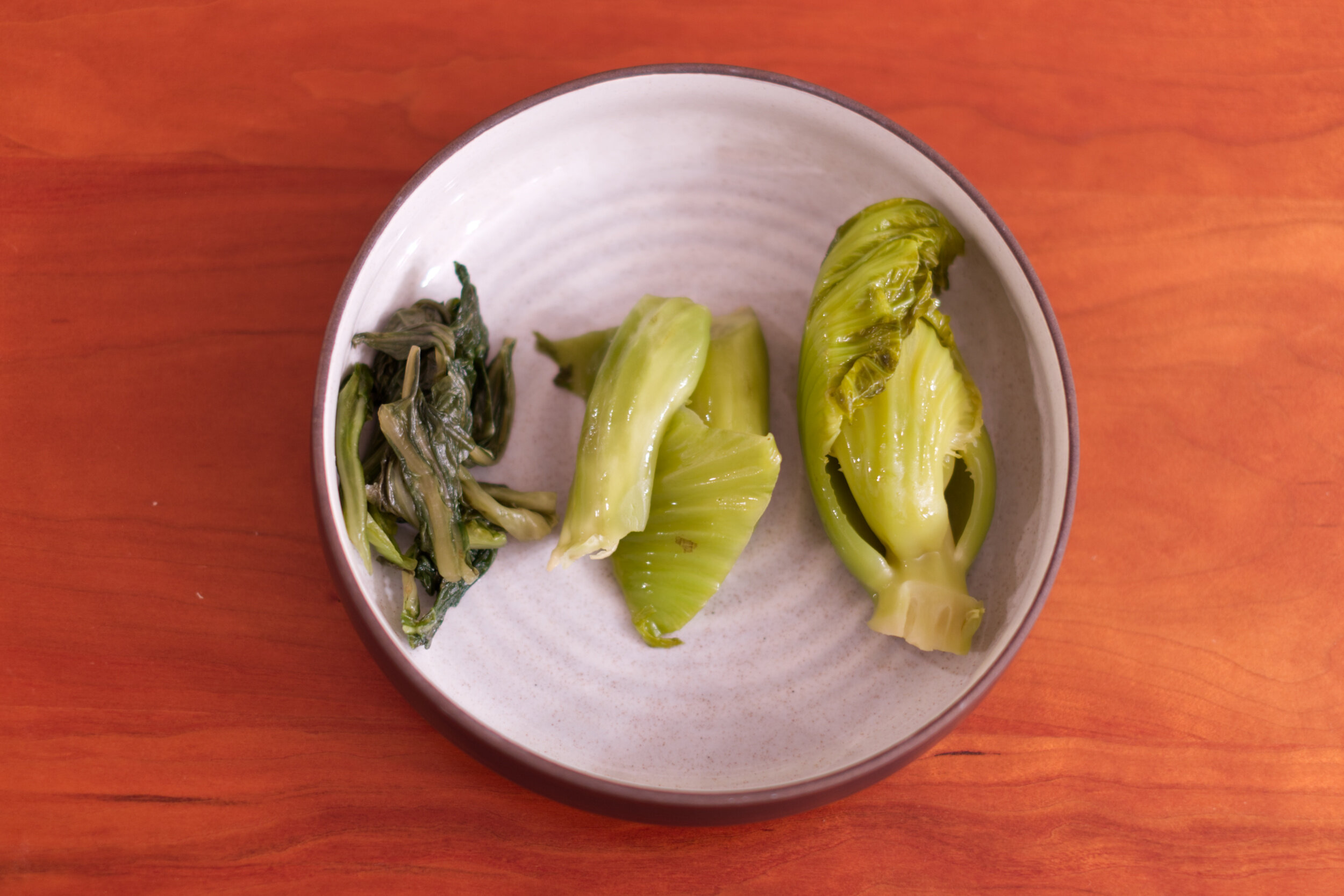Fermented Mustard Cabbage - 鹹酸菜 - haam syun choi

I miss the taste of 鹹酸菜 haam syun choi that my parents made. I really don’t like the packaged ones sold at the grocery stores because they’re too sweet for my taste. The store bought stuff is really not the same because they’re all vinegar brined. I started this at the end of August and fermenting mustard cabbage is best started in hot weather when mustard cabbage has matured properly for this.
My dad says making this is pretty easy and there’s a slow way and a fast way. After describing the fast way, I can tell now that the packaged stuff sold at the grocery stores are made this way. Starting with washing and cutting mustard cabbage, you do a quick blanch in pretty hot water (about 90C until the vegetables start changing color to show it’s partially cooked) and it’s removed from the poaching water, quickly cooled by running through cool water, and transferred to a jar where a brine of sugar, salt, vinegar, and water is added to it. If you make this in the morning, it will be ready to eat that very same night.
I’m not going to do a recipe for the quick way. Instead, the slow way is through lacto fermentation. It’s just salt that’s added to the mustard cabbage and then you wait. As vague as this is, there’s a few more details involved. It’s not complicated at all.
First, you want to find the nicest kind of mustard cabbage for fermenting. You want to find ones with thick stems and are less leafy. The best part in the end will be the stems and core. If you use mustard cabbage that’s too young, they will get too soft during the fermentation. Smaller mustard cabbage are best for fresher preparation like steaming or blanching. You’ll want each plant at least one pound.
When I dug around to see what others were doing online for this, it seems like there’s a lot of brining with vinegar. While there’s nothing wrong with that, even with a salt only brine, it would dilute some of the natural flavor of the mustard cabbage. I’ve also seen some advice that mustard greens can be used and while technically this is true, I wouldn’t recommend it since the stems of mustard greens are much more fibrous and much leafier. I also generally don’t like leaves as it ferments for a long time such as kimchi. I prefer the leafy parts on kimchi when it’s pretty fresh, but with more fermented kimchi, I prefer the stem part of the napa cabbage.
My dad said when he was growing up and times were tough, his family would also make this same kind of preparation with regular cabbage. It’s the same process with the fast pickling method and with longer fermentation, the only difference is that you’d split cabbages into quarters and follow the rest of the general steps. He said this was made in very large batches, where you’d step onto the cabbage quarters to pack them into a very large fermenting container, then place a large stone to weight it all down and it would ferment very slowly for about two months.
In the end, this is a very simple recipe and only requires 3 ingredients: mustard cabbage, salt, and patience. Besides eating this like a side dish, this is most commonly part of a stir-fried dish with beef. Fermented mustard cabbage is also great minced along with soup noodles. You can also use a splash of the brine to season soups as well.
Recipe:
3 lbs of large mustard cabbage
Salt
Rinse thoroughly to clean off any dirt and to flush out any small bugs hiding in the crevices of the cabbage.
Drain over a colander until the mustard cabbage and let it air dry so it’s not dripping wet, like you would have found it at the grocery store. This is to remove excess water.
Cut the mustard cabbage into large pieces, separating the cores, meaty parts of the stems, and the leaves.
In a large bowl, set this on a scale and tare the scale. Add the cut mustard cabbage to the bowl and take note of the weight of it. Calculate 3% of the mustard cabbage weight and add this much in salt. (See note at the end of the post.) Toss to evenly with your hands and leave out for about one hour or until some liquid begins to seep out of the mustard cabbage.
In clean large glass jar, pack the mustard cabbage into it by squeezing out excess salt water (leave the salt water in the same bowl). Add the pieces of core and stems to the bottom of the jar and pack it in. Top with the leaves. It is okay to have pockets of air early on in this kind of fermentation. Do not pack a jar all the way to the top as it will bubble over during fermentation. At most, only pack it so it is about three-quarters full. Once you pack in all of the mustard cabbage, add in all the salt water drawn out of the cabbage into the jar.
*Optional: If you don’t feel confident with the amount of salt you added (my dad doesn’t weigh any amount honestly just eyeballs it since he’s made it so many times), you can sprinkle some extra salt over the top.
If you want to be safe, place the jar(s) in a large pot or something to catch any liquid that may bubble over from the fermentation period. Place in a dark cool place for about 3 days. Periodically, you will want to crack open the jar to let out the CO2 so the pressure doesn’t build up too strong in the jar.
(Pictured above in three pictures: 1) After initial packing 2) after 24 hours of fermenting, 3) after 72 hours of fermenting)
You will notice during the first part the fermentation that the CO2 that bubbles out will also push up some of the vegetables so you’ll still get large air pockets. As it ferments, you will see more brine being made. The salt will continue to draw out more water from the mustard cabbage and the lacto fermentation will slowly make this salty mustard cabbage juice progressively more sour. After 3 days or when the vegetables start to turn yellow-ish in color, transfer this to a fridge. This is also why the store bought vinegar made ones are also dyed with some yellow food coloring to resemble the old and traditional way of making it.
Wait for about 30 days. This fermentation will continue in the fridge but at a much slower pace. My mom says you can start eating this around as early as 22-25 days. After this has been sitting in the fridge for at least 3 weeks, you can start tasting it a little to see when it’s best. If you let this sit longer, it will also slowly get more sour over time.
This recipe was made with 3% salt as my first attempt and I personally think this is too much salt. Next time, I’m guessing to try it with 2.5% salt by weight and see where it goes. If it is too salty for your taste, you can always take a little out and soak it briefly in water to flush out some of the salt.








